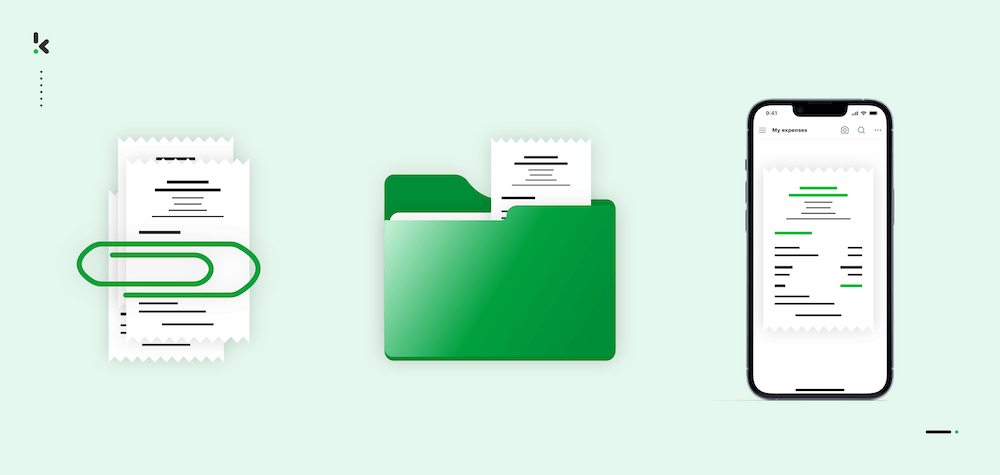

Saving receipts can lead to a lot of frustration. Just before the VAT return, panic sets in because “where has that one receipt gone”? And what exactly was written on that faded, illegible receipt?
All company expenses must be recorded in the accounting system, making it essential to securely store receipts. Doing so can save both time and money. Luckily, with our three tips and digital solution, storing receipts becomes much easier.
Why Saving Receipts is Important?
Understanding the importance of retaining receipts is essential before considering the following tips. Compliance with bookkeeping regulations is paramount, requiring businesses to maintain and preserve records for a legally mandated period.
In the Netherlands, for instance, companies and self-employed individuals must retain their records for 7 to 10 years to ensure they can be audited as required by law. Non-compliance with these regulations can lead to significant fines, underscoring the critical importance of saving receipts.
Receipts become illegible over time
Storing receipts properly is important because over time they fade, or even become completely unreadable. But, how is this possible?
Receipts are printed on thermal paper. When exposed to sunlight, friction, moisture, grease and heat, the paper fades, making the letters illegible. Therefore, do not store your receipts in leather wallets and plastic sleeves. In any case, make sure you store them in a dark, cool place.
Tips for Saving Your Receipts
There are some rules associated with saving receipts. Make sure you do this in the right way because improper storage can cost you money and time. To avoid this, we have prepared a few tips for you.
Tip 1: Make sure you save your receipts digitally
As mentioned earlier, receipts mainly fade quickly in your wallet. In this way, your receipts will not make it to the retention period. Therefore, it is advisable to save your receipts and invoices digitally, which can be easily done using a receipt-saving app.
Digital storage can be done by making a copy or taking a picture of the receipt. Make sure you do not wait too long, since receipts fade quickly.
Tip 2: Schedule a set time to process your receipts
Pick a set time to process all your receipts and stick to it. Don’t leave receipts waiting until the last minute. By processing frequently, at least you won’t have a pile of receipts waiting for you for the VAT return.
What works even better is to process receipts immediately upon receipt. This prevents receipts from disappearing into the bottom of your bag or pocket and crumpling before you’ve had a chance to process them.
Tip 3: Choose a good processing module for receipts
If you really want to make it easy on yourself, make sure you have a good receipt processing module. With software like Klippa, all you have to do is take a picture of the receipt. Upload this receipt via the app, email or web browser, and the data will automatically be extracted by the built-in OCR technology.
By digitizing your financial records, you will never lose a receipt again, every record remains readable, and you can integrate it with your ERP or bookkeeping system.
Easily Save your Receipts Digitally with Klippa
When you save receipts digitally, it’s essential to ensure that the original documents are captured completely and accurately. Klippa’s solution not only meets but exceeds the compliance requirements set by tax authorities, providing you with confidence and ease of use.
Here’s how the process works:
Step 1: Capture the receipt
Take a clear photo of the receipt using your smartphone or other devices. Ensure that the entire document is visible and legible in the image.
Step 2: OCR technology extracts the data
Once the photo is taken, Klippa’s advanced OCR (Optical Character Recognition) technology automatically scans the receipt. It extracts all relevant data, such as the date, vendor, total amount, and VAT, with high precision.
Step 3: Store the data in the cloud
After the data is extracted, it’s securely stored in Klippa’s cloud environment. The original receipt image is also saved, ensuring you retain a complete and accurate digital copy. This cloud storage is secure, compliant with regulations, and designed to keep your records safe for many years.
Step 4: Integrate with your accounting or ERP system
Klippa’s solution offers seamless integration with your existing accounting or ERP system via an API connection or our platform. This means that all the data from your receipts can be automatically synchronized with your financial records, eliminating manual entry and reducing errors.
Step 5: Long-term archiving
Receipts are preserved in the cloud for as long as needed, ensuring they are easily accessible for audits, reviews, or any future reference. This long-term archiving capability protects your documents from physical damage or loss, giving you peace of mind.
FAQ
Digital storage can save space, reduce the risk of loss or damage, and facilitate easy searching and sharing.
Receipts can be stored physically (e.g., in folders or binders) or digitally (e.g., scanned and stored in cloud-based platforms).
Expense management software can automate the receipt scanning process, categorize expenses, and generate expense reports.
The IRS requires businesses to maintain accurate records of income and expenses to support tax returns. This includes saving receipts for eligible deductions.